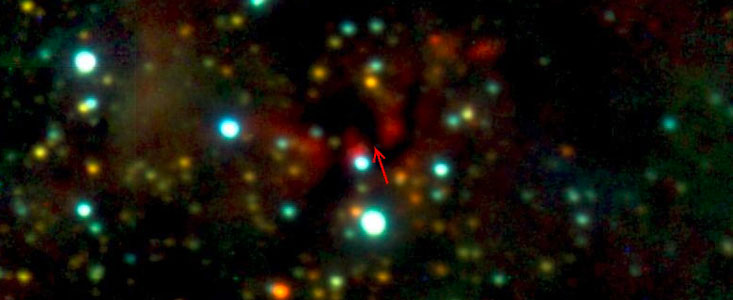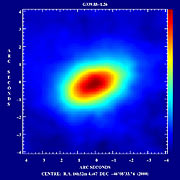Persbericht
First Circumstellar Disk around a Massive Star
24 juni 1998
Observations with an infrared-sensitive instrument at the ESO 3.6-m telescope at La Silla have for the first time shown the presence of a disk around a hot and massive star, known as G339.88-1.26. Until now, disks have only been found around less massive stars. Planets are formed in such disks. The new discovery may thus have important implications for our understanding of the formation of planetary systems around stars.
TIMMI observations
Observations at mid-infrared wavelengths were carried out in July 1997 by Bringfried Stecklum (Landessternwarte Thüringen, Tautenburg, Germany) and Hans-Ulrich Käufl (ESO), using the TIMMI instrument at the ESO 3.6-m telescope. Additional measurements were carried out in March 1998.
TIMMI (T hermal I nfrared M ulti M ode I nstrument) is a general-purpose camera spectrometer operating at a wavelength of 10 µm. To reach sufficient sensitivity, the camera must be cooled to approx. -260 o C, i.e. a few degrees above the absolute minimum, by use of liquid Helium. Astronomical objects whose temperatures are between -120 o C and 300 o C radiate most of their energy at this wavelength. In addition, dust and haze that are absolutely impenetrable for light visible to the human eye, are often found to be nearly transparent at this wavelength. This is why fire-fighters now use similar equipment to look through smoke.
G339.88-1.26: A very special object
Earlier observations with radio telescopes of the object G339.88-1.26 , deeply embedded in an interstellar nebula, had been interpreted in terms of the possible existence of a circumstellar disk around a high-mass star. It was concluded that the star responsible for heating the surrounding gas must be very hot and also that it must be intrinsically very bright. The star, most likely of spectral type O9, would have a luminosity 10,000 times higher than that of the Sun and a mass of about 20 times that of the Sun. From the measured velocity, the likely distance of this object is about 10,000 light-years.
The object is associated with several "spots" of very strong radio emission from methanol molecules (methanol masers). Interestingly, they form a chain in the sky and the measured velocities of the individual spots are indicative for orbital motion in a rotating disk around the central star.
The circumstellar disk
The new TIMMI observations of G339.88-1.26 showed an elliptical object with strong infrared radiation. The peak of this radiation (as seen in the sky) coincides with the peak of the radio emission. Furthermore, the apparent orientation of the disk is well aligned with that of the methanol maser "spots". There is little doubt that this object is indeed the infrared image of a circumstellar disk, viewed at an angle.
As far as known, this is the first direct image of a disk around a very massive star. At a wavelength of 10 µm, however, the central star that is responsible for heating the dust disc, cannot be seen in spite of its rather high luminosity. This is because it radiates mostly in the ultra-violet part of the spectrum. Moreover, the dust disk in which the hot star is embedded, absorbs the stellar ultraviolet light extremely efficiently, thereby re-emitting this energy in the infrared. And any stellar light that escapes the dust shroud is in any case completely blocked by intervening interstellar material in the nebula.
Implications of the discovery
The formation of disks of dust and gas around young stars is now considered to be a normal feature of star formation. This is well established for stars of about the size and mass of our Sun. However, until now there has been no direct evidence of such disks being also formed around young massive stars.
In view of the extremely high luminosity of such massive stars, any surrounding disks are subject to a fierce attack by the enormous flux of light to which they are exposed. Hence the existence of such disks around massive and luminous stars has been questioned by astronomers interested in the physical process of star formation.
The discovery of the disk around G339.88-1.26 now settles the question whether such disks can indeed be formed and are stable over periods long enough that they can be observed.
Supplementary measurements to investigate the molecules and dust around G339.88-1.26 have been performed with the SEST submillimeter telescope at La Silla in March 1998. Near-infrared images have also been taken at the NTT and at the 2.2-m telescope.
The team responsible for this project also includes Thomas Henning and Markus Feldt (Astrophysikalisches Institut & Universitäts-Sternwarte, Jena, Germany), Andreas Eckart (Max-Planck-Institut für extraterrestrische Physik, Garching, Germany) and Lars-Åke Nyman (ESO).
Further information is available at URL: http://www.tls-tautenburg.de/TLS/index.php?id=46&L=0
Over dit bericht
| Persberichten nr.: | eso9828 |
| Legacy ID: | PR 08/98 |
| Naam: | G339.88-1.26 |
| Type: | Milky Way : Star : Spectral Type : O |
| Facility: | ESO 3.6-metre telescope, MPG/ESO 2.2-metre telescope |
| Instruments: | TIMMI |
Our use of Cookies
We use cookies that are essential for accessing our websites and using our services. We also use cookies to analyse, measure and improve our websites’ performance, to enable content sharing via social media and to display media content hosted on third-party platforms.
ESO Cookies Policy
The European Organisation for Astronomical Research in the Southern Hemisphere (ESO) is the pre-eminent intergovernmental science and technology organisation in astronomy. It carries out an ambitious programme focused on the design, construction and operation of powerful ground-based observing facilities for astronomy.
This Cookies Policy is intended to provide clarity by outlining the cookies used on the ESO public websites, their functions, the options you have for controlling them, and the ways you can contact us for additional details.
What are cookies?
Cookies are small pieces of data stored on your device by websites you visit. They serve various purposes, such as remembering login credentials and preferences and enhance your browsing experience.
Categories of cookies we use
Essential cookies (always active): These cookies are strictly necessary for the proper functioning of our website. Without these cookies, the website cannot operate correctly, and certain services, such as logging in or accessing secure areas, may not be available; because they are essential for the website’s operation, they cannot be disabled.
Functional Cookies: These cookies enhance your browsing experience by enabling additional features and personalization, such as remembering your preferences and settings. While not strictly necessary for the website to function, they improve usability and convenience; these cookies are only placed if you provide your consent.
Analytics cookies: These cookies collect information about how visitors interact with our website, such as which pages are visited most often and how users navigate the site. This data helps us improve website performance, optimize content, and enhance the user experience; these cookies are only placed if you provide your consent. We use the following analytics cookies.
Matomo Cookies:
This website uses Matomo (formerly Piwik), an open source software which enables the statistical analysis of website visits. Matomo uses cookies (text files) which are saved on your computer and which allow us to analyze how you use our website. The website user information generated by the cookies will only be saved on the servers of our IT Department. We use this information to analyze www.eso.org visits and to prepare reports on website activities. These data will not be disclosed to third parties.
On behalf of ESO, Matomo will use this information for the purpose of evaluating your use of the website, compiling reports on website activity and providing other services relating to website activity and internet usage.
Matomo cookies settings:
Additional Third-party cookies on ESO websites: some of our pages display content from external providers, e.g. YouTube.
Such third-party services are outside of ESO control and may, at any time, change their terms of service, use of cookies, etc.
YouTube: Some videos on the ESO website are embedded from ESO’s official YouTube channel. We have enabled YouTube’s privacy-enhanced mode, meaning that no cookies are set unless the user actively clicks on the video to play it. Additionally, in this mode, YouTube does not store any personally identifiable cookie data for embedded video playbacks. For more details, please refer to YouTube’s embedding videos information page.
Cookies can also be classified based on the following elements.
Regarding the domain, there are:
- First-party cookies, set by the website you are currently visiting. They are stored by the same domain that you are browsing and are used to enhance your experience on that site;
- Third-party cookies, set by a domain other than the one you are currently visiting.
As for their duration, cookies can be:
- Browser-session cookies, which are deleted when the user closes the browser;
- Stored cookies, which stay on the user's device for a predetermined period of time.
How to manage cookies
Cookie settings: You can modify your cookie choices for the ESO webpages at any time by clicking on the link Cookie settings at the bottom of any page.
In your browser: If you wish to delete cookies or instruct your browser to delete or block cookies by default, please visit the help pages of your browser:
Please be aware that if you delete or decline cookies, certain functionalities of our website may be not be available and your browsing experience may be affected.
You can set most browsers to prevent any cookies being placed on your device, but you may then have to manually adjust some preferences every time you visit a site/page. And some services and functionalities may not work properly at all (e.g. profile logging-in, shop check out).
Updates to the ESO Cookies Policy
The ESO Cookies Policy may be subject to future updates, which will be made available on this page.
Additional information
For any queries related to cookies, please contact: pdprATesoDOTorg.
As ESO public webpages are managed by our Department of Communication, your questions will be dealt with the support of the said Department.


